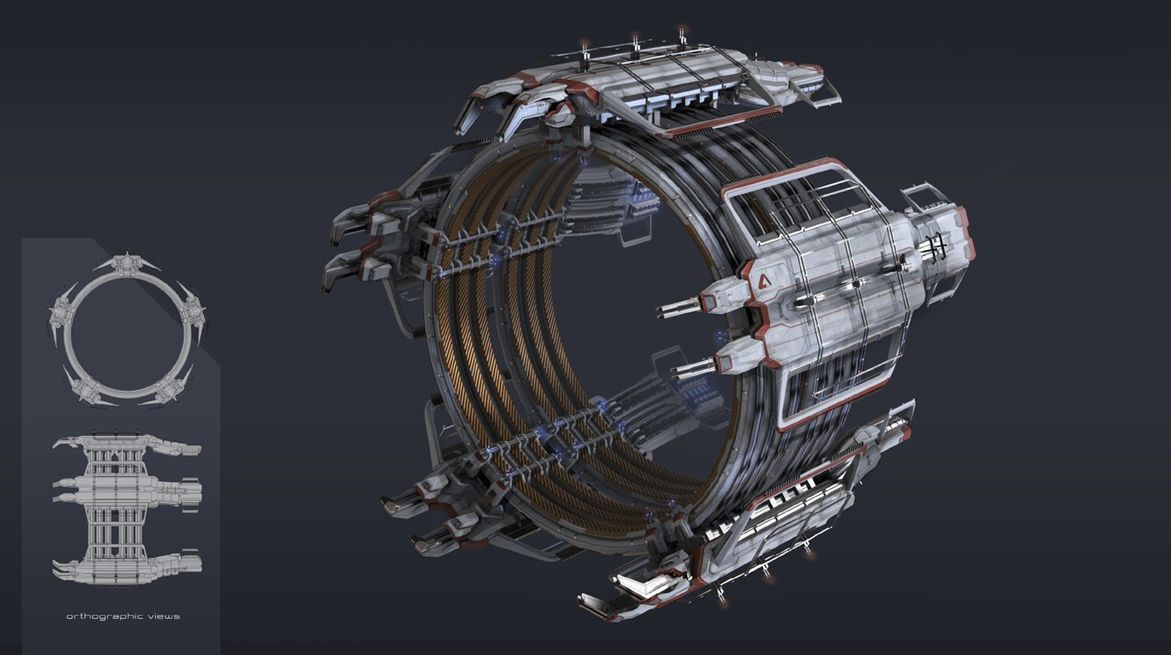Pathstone Project

| |
| Dalacari Megastructure | |
| Class Information | |
| Class: | Dalacari Megastructure |
| Role: | Transit |
| Expected Design Duration: | Unknown |
| Time Between Minor Refit: | Unknown |
| Time Between Major Refit: | Unknown |
| Time Between Resupply: | Unknown |
| Dimensions | |
| Length: | 1600 Meters |
| Width: | 1000 Meters |
| Height: | 250 Meters thick |
| Decks: | 7 |
| Personnel | |
| Total Crew: | 1650 |
| Officers: | 150 |
| Enlisted: | 1500 |
| Marines: | 50 |
| Propulsion | |
| Propulsion Systems: | Sublight
Warp
|
| “Efficient” Cruising Velocity: | 1/10th Impulse |
| Maximum “Sustainable” Velocity: | 1/8th Impulse |
| Emergency Velocity: | 1/4 Impulse |
| Armaments | |
| Energy Weapons: |
|
| Launchers: |
|
| Payload Types: |
|
| Shielding Systems: |
|
| Defensive Systems: |
|
| Auxiliary Craft | |
| Facilities: |
|
| Support Craft: |
|
| Other | |
| Additional Features: |
|
| [ Source ] | |
Overview:
The Pathstone project is, as described, a ring-shaped megastructure in orbit over a star devoid of planets that support life. Many stars were surveyed before a suitable candidate was found, and what dead planets were there were broken up and mined for the resources needed to build both halves of the structure. The ALPHA quadrant megastructure is located orbiting a star near the Galador system. The device works by siphoning off stellar matter to convert into energy, which charges the super-capacitors of the device. This process takes roughly seven hundred and twenty hours, or thirty standard Terran days. Once charged, the system can activate, allowing roughly two hours worth of a window to transit through to the other end of the device. At first, transit was dangerous as there was no ‘receiving’ device, which was why the initial ships sent were automated drone assembly ships. They brought the resources and the automated work force which constructed the second half of the structure around a pre-determined star. Once both systems were synchronized and active, the Pathstone project was declared a success with the first live starship transit.
Pathstone operates by forming a colossal artificial quantum tunnel, utilizing over twenty kilograms of quantum entangled matter. The aperture is roughly one kilometer wide, allowing for fleet movements during the limited operational window but at the current design, transit cannot be simultaneously bidirectional. Ships travelling through the Pathstone wormhole must exit before any ships on the other end can make the trek.
There is a minor delay to traverse through the Pathstone wormhole. Deflector and navigational harmonics must be synced to properly use the Pathstone. This takes hardly any time at all with a properly trained crew and can be done while the craft is in queue to use the device. Without proper attunement, the ship will not pass into the quantum tunnel, and will instead pass harmlessly through the device’s aperture.
The locations of each half of the Pathstone project are as follows. On the ALPHA quadrant end, System TX-8311 in the Kotaki region was selected as it met all the criteria needed. It is located near the Galador system. On the DELTA quadrant end, the Pathstone device orbits the star of the Wayfinder system, so named for the specific purpose of hosting the Pathstone device.
Physical Dimensions:
The Pathstone Generator operational iris is roughly 1km in diameter, with the structure itself slightly wider to accommodate the five reactor stations and the primary operational offices. Each of the five reactor housings and operation offices measures 250m high by 1600 meters long.


